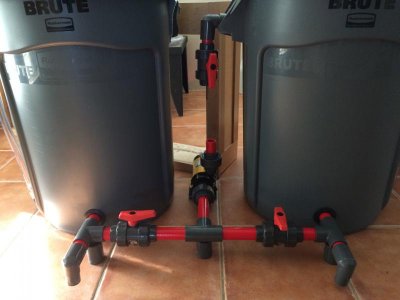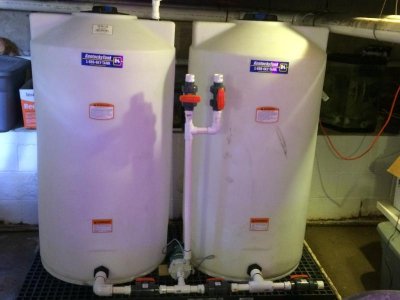Awesome thread. I read the whole thing this weekend

I started plans for a water mixing station earlier in the week and then found this thread which answered a lot of my questions. Mine is just a redendering at this point. 5 basic functions here. RODI on the left, salt on the right. Tanks will hold 30-50g each. The tanks are there for reference as I haven't decided what I will go with yet. Thanks to you all for finding the Roto Molds from RuralKing with free shipping!
1. Move RODI to the salt container.
2. Mix water in the salt container.
3. Send RODI to the ATO container at the tank.
4. Send salt to the sump during a water change.
5. Fill buckets of either if needed.
I wanted a separate pump for the RODI because I didn't think it was a good idea for the RODI water path to come in contact with the salt path at any point. Could contaminate the water going into the ATO tank. Am I overthinking that bit? Not sure what the RODI pump will actually be at this point, but the Eheim in the drawing is probably overkill. It's just there for reference. I will be using the Eheim 1262 for the salt pump. I haven't worked out the details of actually doing the water change yet (manual on/off of outlets or float switches), so some adjustments might have to be made. I'll also have to take into account any siphons that might be created so that may change things some. I'm also trying to figure out the best way to keep the RODI tank full. I don't want it to just top off. I would rather have it get down to a few gallons and then fill back up. I'm thinking a float switch near the bottom that triggers a solenoid for a set amount of time, a float valve for the RODI inlet just in case the solenoid fails, and possibly another float switch to trigger a hard shutoff in case both of those fail. Anyone have anything they've successfully done here?
What solenoids are you all using with Apex to control RODI flow?
Are the horizontal mounted reed float switches as reliable as the vertical ones? I won't make the system reliant on any one float switch, but I do want to start off with something relatively reliable.

Thanks all for the great inspiration in this thread.








